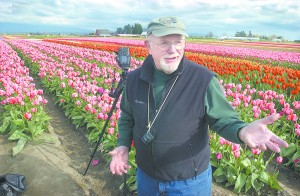
When I plan my big trip of the summer, I usually have a goal in mind as early as January and certainly by April for a climb in the high North Cascades. This year was different-- I didn't choose Porcupine Peak until mid-May. As with the past few years, my destination is influenced by conservation work, in this case American Alps Legacy (americanalps.org). I wanted to get right to the heart of the area that is currently unrecognized as anything more than a scenic highway. I should hope you'll find these pictures and wrds show something more than a strip of pavement.

[photo: confluence of Swamp Creek--flowing from right to left and Granite Arm, Skagit River--flowing left to right. Headwaters of the Skagit River in the Unites States]

[photo: Porcupine Creek flows to Granite Arm, Skagit River. Next stop for this snow is the San Juan Islands.]
May is late to select a destination, because much study of maps and consideration of route, climb and variables, not to mention a healthy dose of excitement/anticipation, go in to the pre-trip planning. As it turned out, I didn't make the final call on approach/route until the night before I left. And I scored a direct hit! Instead of going for the overland, no-trail route to a set of steep 200' pitches to reach base camp on a narrow ridge, I went with a more relaxed approach up Cutthroat trail, acknowledging my true climbing days are coming t an end, and I wasn't going to summit Porcupine Peak. I was going to (be in) a place to live and experience over the course of days--a mountaineering concept I've always embraced. That place is an unnamed ridge/mountain I've taken to calling "Swamp Mountain", as this 7,500’ running ridge defines and is defned by Swamp Creek and Porcupine Creek--the true headwaters of the Skagit River, the third largest river on the west side of the contiguous 48 states, and home to some of the largest runs of wild salmon remaining in the lower 48.
Even without a summit, there was so much snow that "the trail route" was no picnic. Here the mountains are much larger, much more challenging, and far less visited, at least with the healthy snowpack, so that I didn’t see another person for three days. Above Cutthroat Lake there were failing footprints leading to trackless snowy forest. Route-finding is key to any mission, and while not lost, I was feeling a bit uncomfortable as I wandered through the forest trying to pick my way--I had not studied this approach for months and have only hiked it once in my life. But using cues from surrounding peaks and a few goat tracks, I quickly got my bearings and had a wonderful ascent directly to the place I had hope to be--a lovely flat spot on a ridge close to the summit of Swamp Mountain (7,552').
Not even I, the Cornice Camp Kid, could imagine how great this camp would be. A double-cornice was waiting for me. On one side, the cornice was some 4 meters high/thick, overhanging 130 meters of free air above Swamp Creek. On the other side was a 35-degree snow slope for about 30 meters; both sides sculpted by winter/spring winds to make for a flat spot I didn't need to groom at all. Awesome.


The snow conditions were the best I've ever seen: firm and consistent throughout all elevations. I only punched through a few times down low in the forest, and up high, I used crampons until noon each day. I celebrate what many view as a constraint. No bugs, plenty of water, and a nice flat camp.
I counted more than 150 named peaks while on the summit, a narrow ridge with a billowing double-cornice that I kept well clear of other than to scoop out some snow for drinking water.
Living up there for three days and getting to know the landscape, it was hard for me to grasp that nothing I was looking at in the proximate area, or even the middle distance is recognized on a federal level as National Park or Wilderness. These mountains and valleys are key to the largest rivers in the region--the true source of life, livelihoods, and quality of life for everyone from fruit farmers on the arid east side of the Cascade crest to sport fisherman on the west side.
Many of my friends and colleagues on the NCCC board lament they can't do what I can do--they're in their 70s, 80s or older. Still, they stay engaged and work as hard for these summits as they ever have, trying to secure the proper protection and recognition so suitable for this incredible landscape. I am thankful that I’m still able to do as much backcountry travel as I do, and hope to never lose my sense of wonder and desire for exploration. I appreciate and am fortunate for the perspective my fellow NCCC board members provide—we recognize that our abilities diminish and accept it as a fact of life. I suspect it will not make us more inclined to call for trams or roads to summits.
I hope you’ll stay interested, too, for while you may not camp or climb these crags, they do contribute to your everyday life if you live in the state of Washington. Become involved, join the North Cascades Conservation Council, and help us in recognizing these lands.

Photo album at
https://picasaweb.google.com/tphammond/SwampRidgeJuly462011?feat=email#






